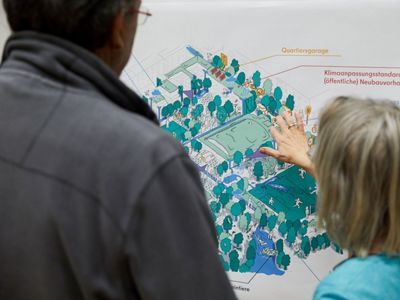Adapting Europe's Urban Landscapes to Climate Change through the Power of Nature

The effects of climate change are here now, and cities in Europe and across the world are disproportionately feeling the consequences. As more people migrate to urban areas—by 2050, 70% of the world’s population will live in cities—the demand on urban systems will only increase. To solve these issues, The Nature Conservancy (TNC) spent five years developing innovative approaches that help cities adapt to and mitigate against the impacts of a changing climate.
What we've learned
Urban greening, a nature-based solution implemented in cities, offers a tremendous opportunity to tackle the climate challenges that affect urban areas in an outsized way. Their benefits are numerous: from cleaning the air to easing the pressure on stormwater systems to providing habitat that promotes biodiversity and ecological balance. There’s also a direct impact on human wellbeing: urban greening provides areas for relaxation, exercise and social interaction, while simultaneously reducing temperatures to keep cities livable in the face of climate change.
The funding, skills and capacity needed to implement these solutions can be challenging, yet city governments, local businesses and communities are clamouring for more information. Through support from Amazon’s Right Now Climate Fund, TNC established the Europe Urban Greening program to provide the needed support. This five-year pilot embedded nature-based solutions into municipal processes, aiming to protect urban residents from climate impacts and secure additional financing for these solutions.
TNC chose Germany as the site for these projects because cities across the country were eager to engage in urban greening efforts, even though they often lacked the municipal resources to do so. Ultimately, TNC and local partners co-created three bodies of work that demonstrate the power of city involvement in finding effective, scalable, nature-based solutions to mitigate the dual challenges of climate change and biodiversity loss.

Creating a Broader Collaborative Model
Charlottenburg-Wilmersdorf District, Berlin
TNC formed a strategic partnership with the Environmental and Nature Conservation Office in Berlin’s Charlottenburg-Wilmersdorf District in 2020. Significant funding from TNC allowed the partners to jointly create a new staff position to provide scientific support, project planning and implementation throughout the project. A focal point of the partnership was creating a districtwide Greenprint, a tool that reveals the range of opportunities for urban greening and benefits provided by natural infrastructure when incorporated into community planning.
Berlin Priority Projects

Innovating for Urban Nature
City of Stuttgart
In Stuttgart, TNC tested a new funding model for urban nature-based solutions that brought together multiple stakeholders from different sectors. Leveraging a €10 million Climate Innovation Fund that the City launched to support net-zero projects by public, private and nonprofit groups, TNC partnered with the Stuttgart municipal government to create a dedicated funding line for urban greening projects.
The goal was to create a financial incentive that would be open to any sector, including for-profit and start-up companies, helping to overcome the incentive gap barrier and accelerate the creation of nature-based solutions for the City. Given Stuttgart’s history of being a site of technological innovation, there was also a focus on the potential creation of an innovative, scalable approach that could continue to replicate on its own in the future. In total, 19 projects were developed.
Stuttgart Urban Greening Projects
Nature-Based Solutions for Mitigating Urban Heat
Partnership with Environmental Action Germany
As climate change continues to elevate temperatures in urban areas, sensitive age groups such as children and the elderly, as well as socioeconomically disadvantaged segments, bear the brunt of these challenges. TNC and partner Environmental Action Germany (Deutsche Umwelthilfe - DUH) collaborated to understand how urban greening can address these impacts. They focused on transforming urban areas, including school campuses, into valuable ecological and climate-resilient areas that simultaneously tackle the growing issue of urban heat, lack of biodiversity and the need for more nature-based solutions in the most densely populated urban areas.

Woods 'R' Us
TNC and DUH collaboratively created Woods 'R' Us to address the health impacts of climate change on children. This program transforms German schoolyards, typically composed of concrete-heavy open spaces with little shade and few natural elements, into green spaces rich in biodiversity, adaptive to the climate and offer shade that cleans and cools the air. The program, which also focuses on introducing students to the wonders of nature, included:
- The planting of "Tiny Forests" in three public schools in Berlin, Bremerhaven and near Frankfurt. These small but mighty groves contributed to the local microclimate and provided a practical learning environment for students.
- National conferences on the theme of nature-based outdoor spaces in childcare facilities and primary schools, which allow decision-makers and practitioners to hear directly from scientific experts from various disciplines and foster exchange that leads to direct action.
- Online symposiums that offer best practices on greening schoolyards. Target groups included educators, local authorities and practitioners.
Knowledge Sharing and Next Steps
When paired together, these pilots become a powerful, multi-pronged approach to climate change that can serve as a template for others looking to implement nature-based solutions in the future. Over the course of the five-year program, TNC gained key insights that municipalities and stakeholders can apply in their own communities:
There is a gap between thinkers and doers: policymakers and planners often have more freedom to innovate, while those implementing and maintaining work face more constraints, leading to bottlenecks for new nature-based solutions.
Securing political backing is crucial, and science and research can help underpin effective policy and decision-making.
Innovation funds, which can be replicated in other municipalities, face the challenge of securing necessary funding.
Engagement from NGOs and the third sector is essential. They can close the gap by supporting public sector work, advocating for policy changes, facilitating experimentation, partnering with the private sector to change business practices, and helping bridge divides.

Download
We Can't Save Nature Without You
Sign up to receive monthly conservation news and updates.














